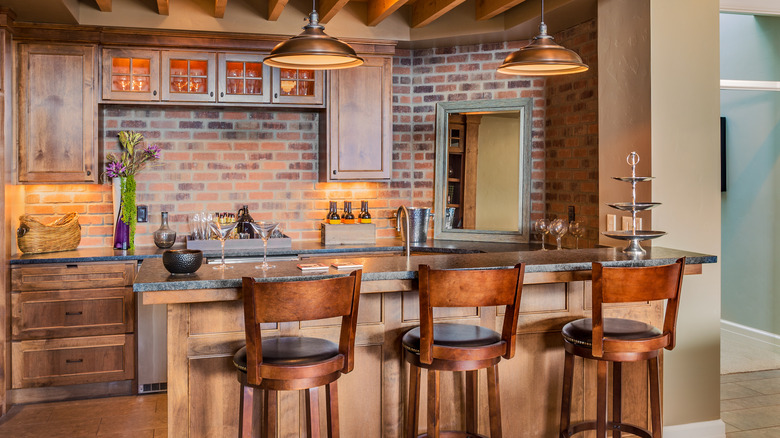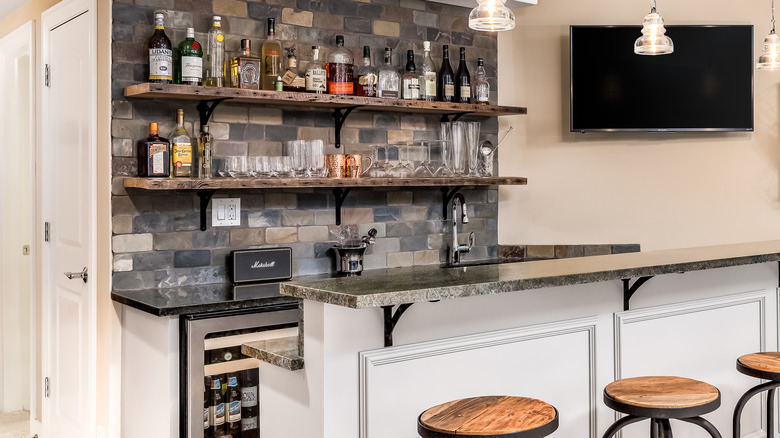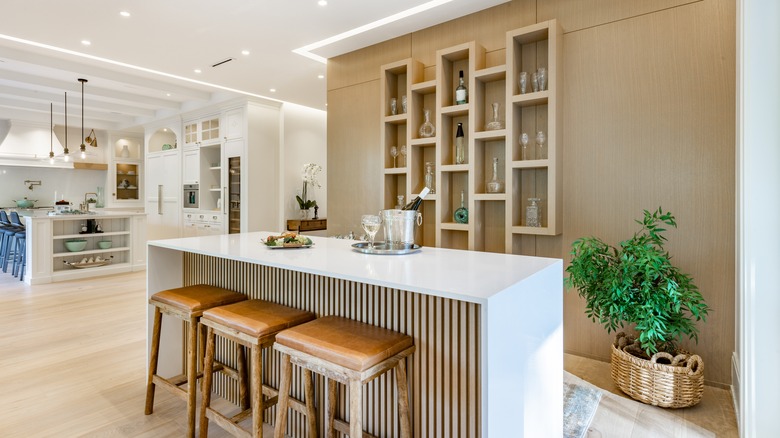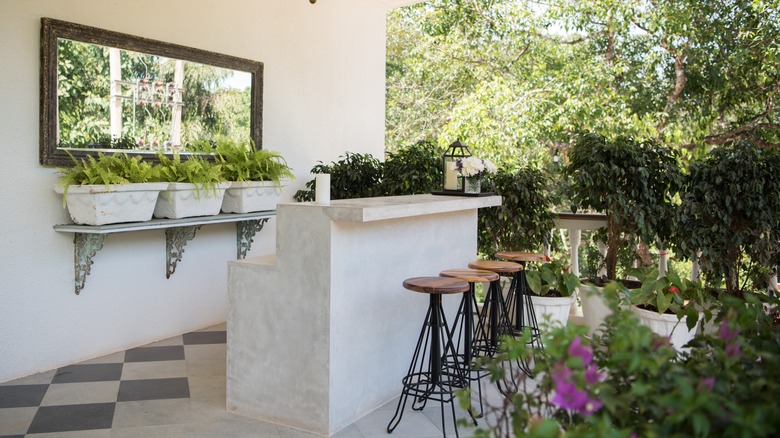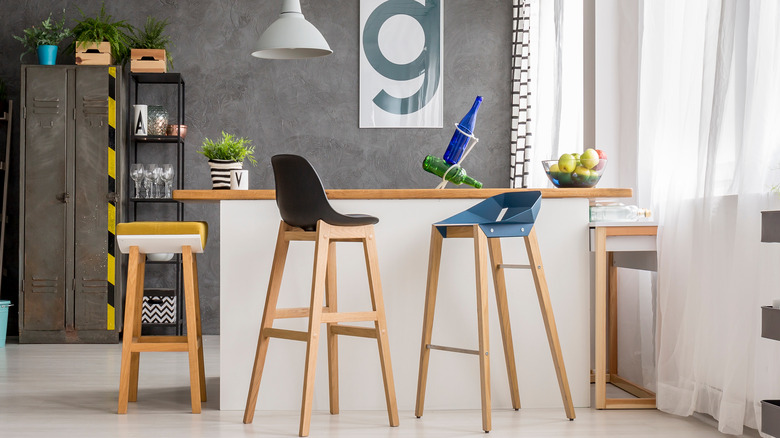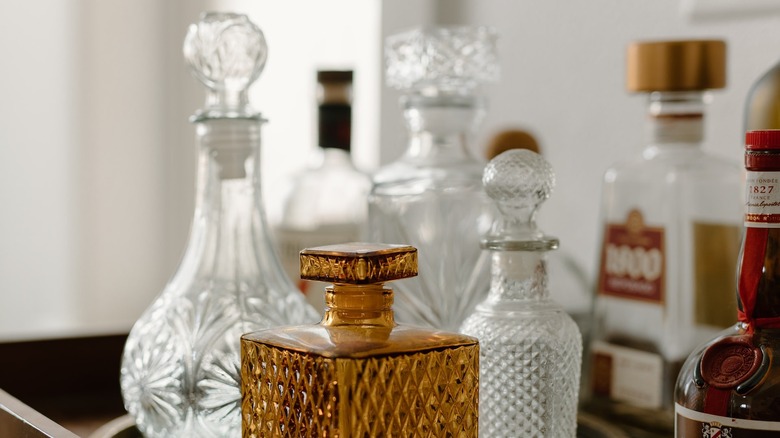Wet Bar Vs. Dry Bar: What's The Difference And Which Is Best For Your Home?
When done right, an in-home bar for displaying and pouring spirited beverages can be a fabulous design feature. The major distinction among in-home bars is that "wet" bars have a fully functional sink, while "dry" bars do not. Home bars are on many peoples' dream lists because they're lavish, timeless, and fun. With enclosed and galley kitchens becoming increasingly popular, more homeowners may be considering installing a bar. Not only will it give them easy drink access, but the opportunity to create special moments, whether that's entertaining guests or having a quiet night in.
The main considerations that will help you make the decision between a wet or dry bar are plumbing, cost, and location (in other words, how close your kitchen is to your bar). There are subtle differences to take into account, too, because the best home bars do more than provide running water. They can show off beautiful glassware, a smart collection of liquors, or a worldly stock of wines. They can also influence the flow of traffic in your home while entertaining. Like many design choices, you won't go wrong if you let your bar be a personal reflection. Here are all the things to consider if the sink-or-no-sink question has you scratching your head.
What is a wet bar?
In-home wet bars are popular with those who do a lot of entertaining or have a sprawling floor plan with entertainment-specific rooms. Wet bars are equipped with a small sink, operable faucet, counter space for snacks and mixed drink prep, and open shelving or cabinets. They are permanent built-in units (often a walk-up bar or an island) that are hooked up to your home's plumbing via water lines and a drain system. They can be made to handle heavy-use entertaining situations and might have a mini-fridge, wine fridge, beer tap, kegerator, ice maker, soda gun, dishwasher, and an electrical outlet. Wet bar sinks are typically stainless steel and about half the size of a standard kitchen sink, according to Build with Ferguson.
Additionally, wet bars often have an accent light or under-cabinet lighting (via Nelson Cabinetry). They can be further accessorized with wine racks, TVs, trays to display glassware, decanters, vintage bottles, cocktail-mixing sets, and a well-curated liquor collection. Mirrors can help your bar look larger, and they'll grab light to reflect it nicely through glassware and bottles. Mirrored walls are a standard design feature for both public and residential bars, and can also be a nod to the disco-inspired design of the 1970s and 1980s when wet bars were all the rage.
Wet bars can be located in any room of your home. They are popular for finished basements, pool houses, home offices, game rooms, or outside entertaining areas, especially those that are far from the main kitchen.
What is a dry bar?
Intended for lighter, more everyday use than a wet bar, a dry bar is about making an attractive display and creating an easy-to-use space for pouring and serving drinks within one's home. Think of a dry bar as a simplified wet bar without a functional sink, yet equally as elegant. As a glorified liquor cabinet, your dry bar can be smaller than a wet bar. It can even be portable because it won't require plumbing. That said, dry bars often have a work surface, electrical capabilities, refrigeration, lighting, or even a non-plumbed sink. According to MasterClass, storage is a key function of a dry bar, and good designs utilize all the vertical space available. For these reasons, dry bars can be located in almost any corner or nook of the home, including a closet, bookshelf, rolling cart, kitchen shelf, or cabinet.
Many people who have a dry bar in their home enjoy showing off their collection of spirits, glassware, and decanters. As with wet bars, owners might accessorize their dry bars with trays in opulent materials, framed vacation photos, potted plants, mood lighting, vintage bottles, and matching barware sets to make their bar a relaxing and personal place to unwind.
Pros of having a wet bar
Having an in-home bar with plumbing will allow you to do more food and drink prep and aid in easier cleanup. You will be able to keep your bar area as tidy as possible, which is a perk if you plan on doing a lot of entertaining. Wet bars are well-suited to those who tend to make mixed drinks or blender drinks, which can involve more accessories and effort than simply opening a bottle of wine. For example, imagine yourself prepping the cherries and orange peels for an old fashioned, or the limes, ice, and salt rims for a batch of frozen margaritas. With a wet bar, you'll be required to make as few trips to the kitchen as possible. That counts for after the party, too. You won't need to tote loads of glasses to the kitchen for dishwashing. Don't forget about ice. Many wet bar owners hook an ice maker to their plumbing system to avoid hauling buckets to and from their kitchen. When entertaining a group, easily fill your wet bar sink with ice to chill drinks, then drain it afterward.
Your guests' experience and how they'll move throughout your home — from the dining room to kitchen to bar — is key to consider, according to Mansion Global. In the company of guests, hosts with wet bars enjoy creating a participatory gathering place. Since people gather where the food and drinks are, they're less likely to crowd your kitchen and more likely to hang out at the bar if you have a complete one. As the host, pouring drinks can be an enjoyable activity you can do while hanging out with everyone. Who knows — you might even become more adventurous in your mixology skills with a live audience and the leisurely sense of time on your side.
Cons of having a wet bar
If connecting to your home's plumbing isn't simple, you'll need to hire a professional to hook up your wet bar. The cost of installing a sink and plumbing will raise your in-home bar "tab" by as much as $2,400, per HomeAdvisor. This cost can increase if the bar is in the basement, where drainage can be an issue, or a wet bar with an island (as opposed to a walk-up bar). US News & World Report suggests thinking of a home bar like a mini kitchen project, in which custom cabinetry and labor, including that of a plumber and interior designer, can be a significant expense. Some people don't want to deal with the potential headaches of having more plumbing in their homes. It's one more thing to leak, back up, or freeze.
Wet bars also require more space than dry bars, which is why some people think they're unnecessary, particularly for modern open floor plans in which the kitchen sink is always steps away. With a wet bar, are you giving up precious under-the-counter space to plumbing that could be used for storage or a wine fridge? Is it possible you'll want to repurpose your wet bar one day? It could require a bit of elbow grease to convert to a desk or reading nook, so it's worth to think twice before installing one. Or maybe you love the idea of designing a bar you can take with you when you move. Built-in wet bars may be a big investment that you'll have to leave behind.
Pros of having a dry bar
Dry bars are easier to DIY and can fit in smaller spaces than wet bars, like nooks and alcoves intended for closets, bookshelves, and cabinets. You can convert an armoire, rolling cart, kitchen shelf, or side table into a dry bar (and convert it back when you're done). That means that even if you rent, you can transform a closet into a bar. The cost will be as little as $500 and can be done over a weekend, according to HomeServe.
A dry bar can have electrical outlets, a mini-fridge, and accent lighting just like a wet bar. A dry bar can look sleeker than a wet bar because it doesn't have a faucet. Instead, the focus can be on your prized collection of barware, vintage decanters, elegant stemware, or limited edition bottles.
Without pipes, there won't ever be any plumbing maintenance needed. You'll get more space under the counter for storage, and more workspace on top of the counter for prepping drinks. That said, a dry bar can be designed with a non-operational dump sink basin (no faucet necessary) with a bucket underneath. It can be used to hold ice, pour out drinks, and do simple cleanup.
Cons of having a dry bar
On the flip side, having a home bar without running water can be pretty inconvenient, especially if you want to make elaborate drinks. Without a sink, you will be stacking up used glassware and dishes, transporting ice through your hallways, and shuttling drink prep items to and from your kitchen. You won't be able to give knives, cocktail shakers, or blenders a quick rinse. Wine Cooler Direct also warns that without plumbing, you won't be able to install an ice maker.
Because dry bars are often installed in small spaces, counter and cabinet space may feel cramped, which could defeat the purpose of installing a home bar in the first place. For example, Cocktail Buff recommends having 5 gallons of fresh drinking water and ice in a cooler. All these things could add up to your dry bar feeling and looking too busy to be relaxing, unless you have ample counter space.
One is more outdated than the other
Dry bars and wine storage have taken the place of once-popular wet bars, according to Nelson Cabinetry. Dry bars have become more common because they are smaller and more adaptable, while wet bars have a way of making people feel like their 1970s and 1980s-era homes are stuck in time. Wet bars symbolized wealth for the postwar generation, but went out of style in the 1990s for several reasons. Beer, wine, and healthy living became more popular. Residential architecture emphasized open floor plans that brought living rooms and kitchens into one adjoined space. According to the Santa Barbara Independent, wet bars were replaced by show-off pieces of the 1990s: entertainment systems and large TVs (and later, home computers).
That said, after a few decades of falling out of favor, wet bars are having a resurgence. Thanks to the craft cocktail trend and the pandemic-led lockdown, drinking at home is in style again. James River Construction says newer wet bar features include wine storage, coffee bar amenities, and plush guest seating.
Is a home bar a smart investment?
If you're wondering whether a wet bar or dry bar will increase the resale value of your home, there are arguments for both sides. The average cost of installing an in-home bar is $8,000, per HomeAdvisor, and it varies widely based on labor, including plumbing and carpentry work. A wet bar, especially if it's part of an outdoor kitchen or finished basement, can have a return on investment of 70%. A wet bar is more likely than a dry bar to increase the resale value of your home, says Rocket Homes.
It's worth considering that some buyers are bound to see home bars as outdated and unnecessary, and they will make it the first thing to go, as per Realtor Mary Pope-Handy. She says buyers are more interested in smart homes, sustainability features, and remodeled kitchens. Other buyers may consider a bar a welcome retro trend or a luxurious amenity that has never gone out of style — and never will.
